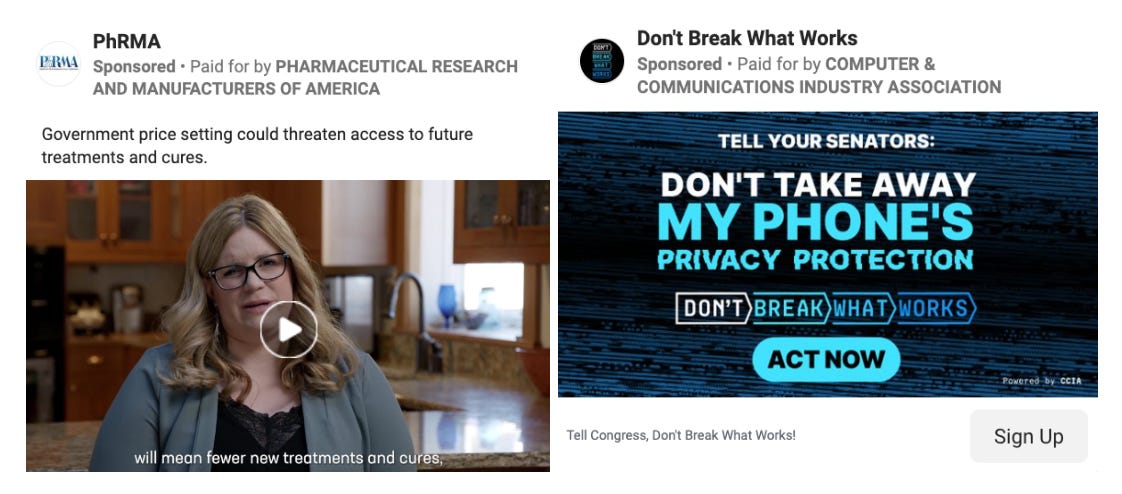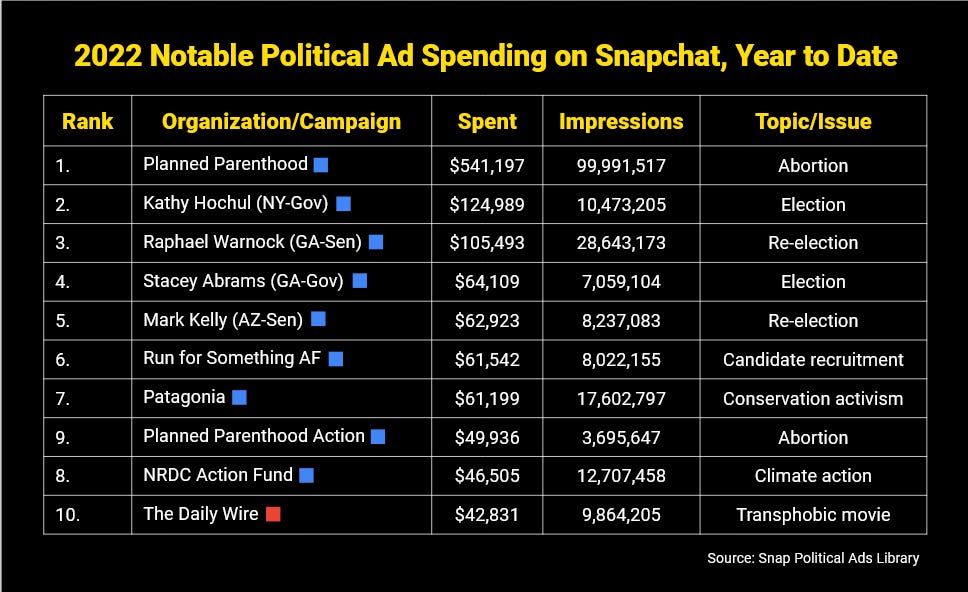Political strategists react to Facebook’s major overhaul
The Tiktok-ification of Facebook (and Instagram) has arrived. Here’s what it means for campaigns.
Yesterday, Meta confirmed what many of us have assumed for quite a while: The company would accelerate the “TikTok-ification” of its flagship app, Facebook. In what one tech journalist called “one of the most audacious pivots a tech giant has attempted to date,” Facebook and Instagram announced they’ll serve users more content from accounts they don’t follow while continuing to emphasize short-form vertical video content.
We’ll break down the changes that were announced yesterday, as well as share some reactions from top political digital strategists. But first…
By the numbers:
FWIW, here were the top-spending political advertisers on Facebook + Instagram last week:
Midterm candidate spending on Facebook and Instagram declined a bit last week. Several of the top spenders were conservative lobbying groups like PhRMA and CCIA attempting to stall congressional legislation on tech antitrust and drug pricing.
Meanwhile, here were the top political advertisers on Google platforms last week, including YouTube:
Democratic Super PAC Senate Majority PAC spent heavily on Google ads last week, blanketing YouTube with videos supporting NV Sen. Catherine Cortez Masto and attacking her opponent.
… and here are the top political ad spenders on Snapchat so far this year:
Looking for more detailed midterm candidate spending numbers? We provide weekly + historical data in battleground races for premium subscribers every week. Here are links to that content for Senate campaigns and Gubernatorial races.
Give us a retweet?
We’re on a quest to get to 20,000 active subscribers by Election Day! While we’re well on our way - we need your help. Can you do us a quick favor and retweet this from one of our all-time favorite Twitter accounts, @OrganizerMemes?
From around the internet:
John Fetterman’s campaign for Senate has launched a “Social Squad” to get supporters to share/amplify content on different social media networks. After signing up, we were redirected to an “official Fetterfans” Facebook group (1.5k members strong) and received a follow-up email to join their *very active* campaign slack channel. 👏 Every 👏 Democratic 👏 campaign 👏 should 👏 do 👏 this 👏 ASAP. 👏
Candidates for president who typically try to stay under the radar until launch time are now increasingly forced to show their hands, vis-à-vis their digital ad operations. Here’s how we are using digital tea leaves to find out who’s running for president in 2024 >>
Progressive lawyer and organizer Veronica Carbajal ran for Mayor of El Paso in 2020, receiving nearly 50,000 votes in a competitive six-way race. Although she ultimately lost, Carbajal channeled her campaign’s energy into a movement for local democracy reform in El Paso. We interviewed Veronica in this week’s issue of Campaigner. Read + subscribe >>
Some pundits and pollsters are becoming a little more optimistic about Democrats’ chances of defying history this November. New research from GOP firm Echelon Insights found Democrats have a slight lead among likely voters on a generic ballot nationwide. Here’s a refreshingly positive thread from Simon Rosenberg about it >>
Content that is shared organically on social media platforms like Facebook can have a much larger impact than paid advertising. Which midterm candidates are receiving the most reactions, comments, and shares on their campaign’s Facebook posts? Here’s a roundup for FWIW premium subscribers >>
Political strategists react to Facebook’s major overhaul
Several months ago, we wrote about the rise of vertical video as one of the defining changes in the world of social media engagement this cycle. So it wasn’t surprising at all when Meta confirmed yesterday what many of us assumed: The company would accelerate that change via the TikTokification of its flagship app, Facebook.
Posting on Facebook, Mark Zuckerberg announced that the platform’s default Home feed would serve as a “discovery engine” to recommend content that they believe users will want to see, from accounts they may not already follow. Content from friends, family, groups, and pages will be lumped into a set of separate, chronological feeds that users have to navigate to later. Similarly, Instagram’s CEO announced that all videos on that platform will now be converted to the TikTok replica “Reels” format, further underlining the company’s emphasis on vertical video.
Platformer’s Casey Newton called it “one of the most audacious pivots a tech giant has attempted to date.” Sara Fischer at AXIOS put it concisely: "By filtering content from personal connections out of the primary Home screen, Facebook’s experience will begin to look and feel much more like a content and product discovery engine than a social networking site."
These changes undoubtedly will have a major impact on political campaigns in the midterms. This cycle, Facebook and Instagram remain the most important social media platforms for reaching many key groups of voters. Much has already been written about some candidates’ Facebook engagement strategies, and we’re certain there will be many, many more words published on the topic. That’s why we reached out to several leading political digital strategists, several of who are working with prominent midterm campaigns, to hear their takes on how these platform changes will impact their work:
Madeline V. Twomey, a digital strategist who is working with campaigns and political TikTok creators this cycle, said:
“Instagram and Facebook have been moving towards this for some time -- first incentivizing creators to make Reels, and later by pushing them into our feeds -- moving not just towards short-form video, but more importantly, away from being a creator-first platform and towards a content-first one…This presents both challenges and opportunities for our community.”
“Content-first means the content needs to be good, and let's be honest, political organizations haven't always created the most entertaining content. Organizations should spend time reflecting on the changes they need to make to create entertaining content that will hold people's attention in-feeds. That could mean hiring additional production staff for filming, editing and script-writing, or bringing in new voices that have a track record of social success from other industries. At a minimum, organizations need to spend time on these platforms and start tracking what works and why, in order to gain momentum on the platform.”
Emmy Bengtson, Co-founder and partner of Wavelength Strategy:
“It’s another reason [why] vertical video is essential, on organic and paid, in terms of matching how voters consume content. Campaigns should already be using vertical video regularly but it seems like this is going to complete the shift on social, between now and when Facebook fully implements the swap.”
Eric Wilson, Republican digital consultant and author of digital political newsletter Learn, Test, Optimize said:
“It’s likely more bad news for campaigns with respect to lead generation, but they should always be testing. But it could also be a win for campaigns if the changes bring more users back to Facebook since they allow political advertising.”
Beth Becker, a digital trainer and consultant who educates progressives on social media platforms:
“How many of the average Facebook users are gonna know to go look at the “feeds tab” vs the Home screen they see when they log on?”
“Bottom line my advice doesn't change much: understand how content gets delivered, but more importantly understand the content your audience wants to see and engage with and give that to them.”
Josh Klemons, a digital consultant for midterm campaigns and creator of the Progressive Digital Professionals community told FWIW:
“Platforms change their algorithms constantly. While this one has the potential to be more substantial than most, the takeaway is the same: if you want to find success on social, you have to find ways to add value to the feed.”
“So many campaigns focus their programs on themselves and their asks. But voters don't care about you - they care about themselves! Find a way to add value to your audience's timeline or you're just clutter in the feed. Humor is great, but you don't need to start dancing to the news to succeed. Educate, engage, entertain, inspire... lean into your values and use them to improve the lives of your audience and you'll be just fine.”
As these changes roll out for more people, their impacts on candidates’ abilities to reach voters will obviously become more clear. The company noted that while these changes will be pushed immediately into Facebook’s mobile app, the changes won’t affect users’ desktop experience until later this year.
Have thoughts on these platform changes? Tweet at us @FWIWNews!










